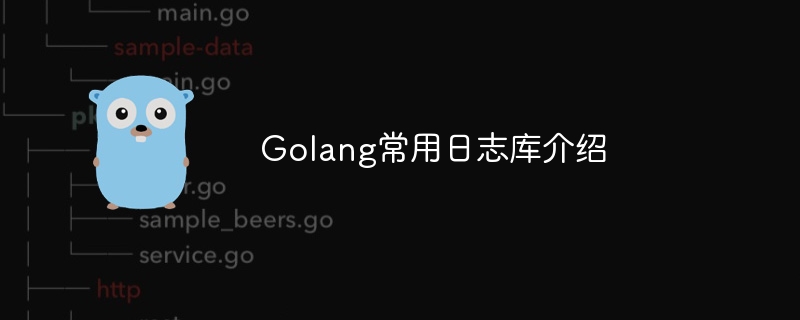Introduction to common log libraries in Golang
Golang commonly used log libraries include "log package", "go-logging" and "zap": 1. log package, built-in Go language, can perform basic logging and output; 2. go -logging, a powerful, flexible and easy-to-use log library that supports multiple formats of log output and level control; 3. zap, Uber’s open source high-performance log library, features structured logging and high customization.

# Operating system for this tutorial: Windows 10 system, Dell G3 computer.
There are several commonly used log libraries in the Go language. I will introduce a few of them below:
-
log package:
- The built-in log package in the Go language provides simple logging functions for basic logging and output.
- Sample code:
package main import ( "log" ) func main() { log.Println("这是一条普通日志") log.Fatalf("这是一条严重错误日志:%s", "错误信息") }Copy after login -
go-logging:
- go-logging is a powerful, flexible and easy-to-use A log library that supports multiple formats of log output and level control.
- Sample code:
package main import ( "github.com/op/go-logging" "os" ) var log = logging.MustGetLogger("example") func main() { backend := logging.NewLogBackend(os.Stderr, "", 0) backendFormatter := logging.NewBackendFormatter(backend, logging.MustStringFormatter(`%{time:2006-01-02 15:04:05} %{level:.4s} %{message}`)) logging.SetBackend(backendFormatter)log.Info("这是一条普通日志") log.Errorf("这是一条错误日志:%s", "错误信息")}Copy after login -
zap:
- zap is Uber’s open source high-performance log library with structured logs Recording and highly customizable features.
- Sample code:
package main import ( "go.uber.org/zap" ) func main() { logger, _ := zap.NewProduction() defer logger.Sync()logger.Info("这是一条普通日志") logger.Error("这是一条错误日志", zap.String("err", "错误信息"))}Copy after login
The above only introduces a few commonly used log libraries, and there are other log libraries worth mentioning, such as logrus, seelog etc. When choosing a log library that suits your project needs, you need to consider factors such as performance, functionality, ease of use, and community support.
The above is the detailed content of Introduction to common log libraries in Golang. For more information, please follow other related articles on the PHP Chinese website!

Hot AI Tools

Undresser.AI Undress
AI-powered app for creating realistic nude photos

AI Clothes Remover
Online AI tool for removing clothes from photos.

Undress AI Tool
Undress images for free

Clothoff.io
AI clothes remover

Video Face Swap
Swap faces in any video effortlessly with our completely free AI face swap tool!

Hot Article

Hot Tools

Notepad++7.3.1
Easy-to-use and free code editor

SublimeText3 Chinese version
Chinese version, very easy to use

Zend Studio 13.0.1
Powerful PHP integrated development environment

Dreamweaver CS6
Visual web development tools

SublimeText3 Mac version
God-level code editing software (SublimeText3)

Hot Topics
 What is the problem with Queue thread in Go's crawler Colly?
Apr 02, 2025 pm 02:09 PM
What is the problem with Queue thread in Go's crawler Colly?
Apr 02, 2025 pm 02:09 PM
Queue threading problem in Go crawler Colly explores the problem of using the Colly crawler library in Go language, developers often encounter problems with threads and request queues. �...
 What libraries are used for floating point number operations in Go?
Apr 02, 2025 pm 02:06 PM
What libraries are used for floating point number operations in Go?
Apr 02, 2025 pm 02:06 PM
The library used for floating-point number operation in Go language introduces how to ensure the accuracy is...
 In Go, why does printing strings with Println and string() functions have different effects?
Apr 02, 2025 pm 02:03 PM
In Go, why does printing strings with Println and string() functions have different effects?
Apr 02, 2025 pm 02:03 PM
The difference between string printing in Go language: The difference in the effect of using Println and string() functions is in Go...
 How to solve the user_id type conversion problem when using Redis Stream to implement message queues in Go language?
Apr 02, 2025 pm 04:54 PM
How to solve the user_id type conversion problem when using Redis Stream to implement message queues in Go language?
Apr 02, 2025 pm 04:54 PM
The problem of using RedisStream to implement message queues in Go language is using Go language and Redis...
 Which libraries in Go are developed by large companies or provided by well-known open source projects?
Apr 02, 2025 pm 04:12 PM
Which libraries in Go are developed by large companies or provided by well-known open source projects?
Apr 02, 2025 pm 04:12 PM
Which libraries in Go are developed by large companies or well-known open source projects? When programming in Go, developers often encounter some common needs, ...
 What should I do if the custom structure labels in GoLand are not displayed?
Apr 02, 2025 pm 05:09 PM
What should I do if the custom structure labels in GoLand are not displayed?
Apr 02, 2025 pm 05:09 PM
What should I do if the custom structure labels in GoLand are not displayed? When using GoLand for Go language development, many developers will encounter custom structure tags...
 Golang's Purpose: Building Efficient and Scalable Systems
Apr 09, 2025 pm 05:17 PM
Golang's Purpose: Building Efficient and Scalable Systems
Apr 09, 2025 pm 05:17 PM
Go language performs well in building efficient and scalable systems. Its advantages include: 1. High performance: compiled into machine code, fast running speed; 2. Concurrent programming: simplify multitasking through goroutines and channels; 3. Simplicity: concise syntax, reducing learning and maintenance costs; 4. Cross-platform: supports cross-platform compilation, easy deployment.
 How to ensure concurrency is safe and efficient when writing multi-process logs?
Apr 02, 2025 pm 03:51 PM
How to ensure concurrency is safe and efficient when writing multi-process logs?
Apr 02, 2025 pm 03:51 PM
Efficiently handle concurrency security issues in multi-process log writing. Multiple processes write the same log file at the same time. How to ensure concurrency is safe and efficient? This is a...






